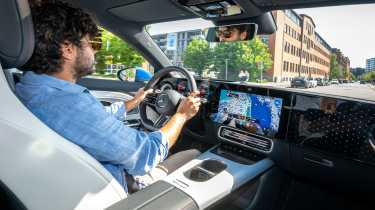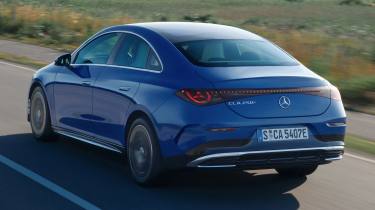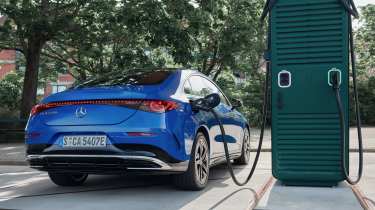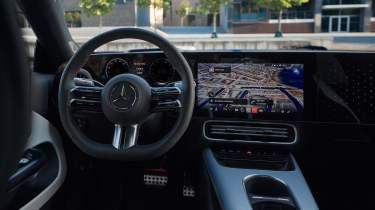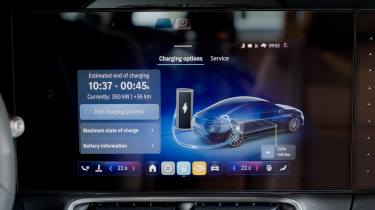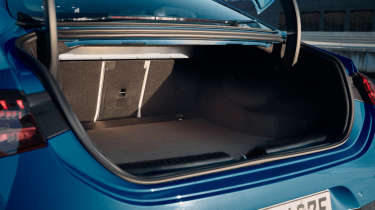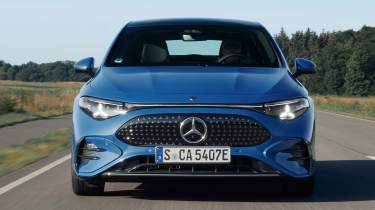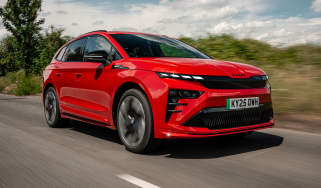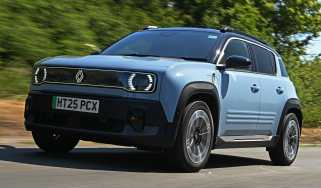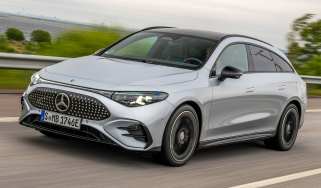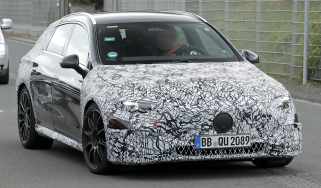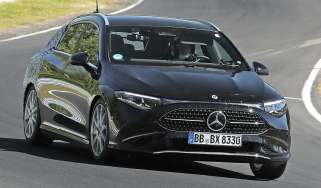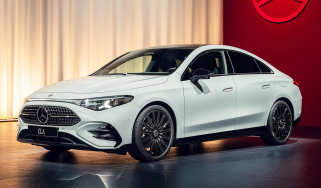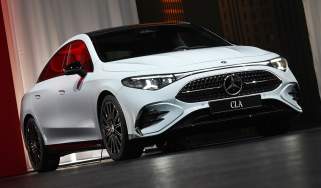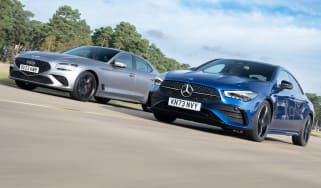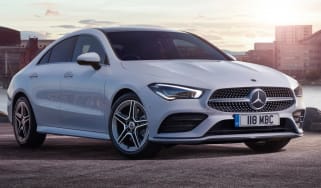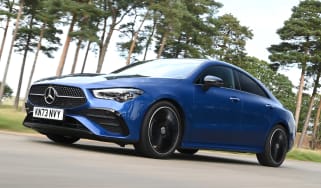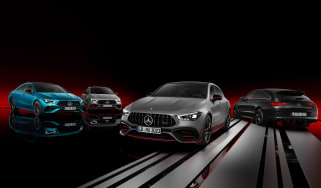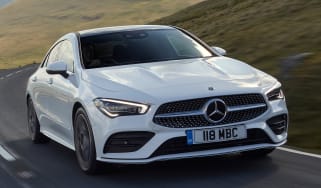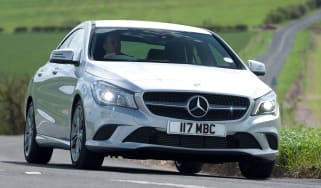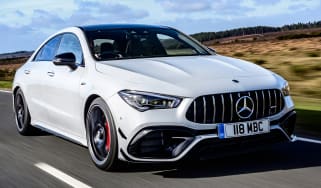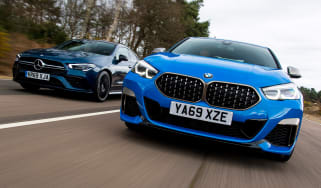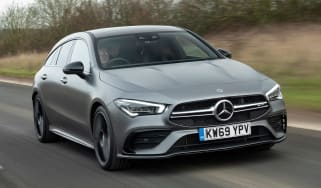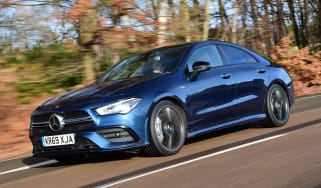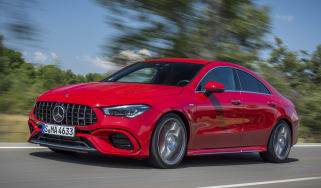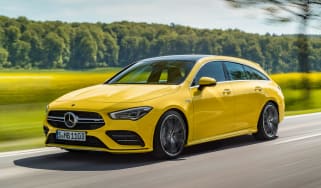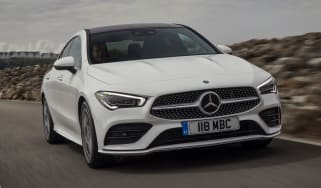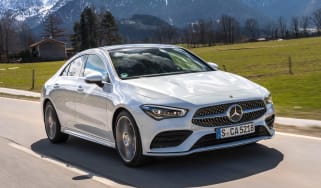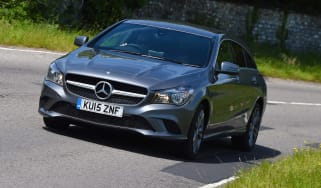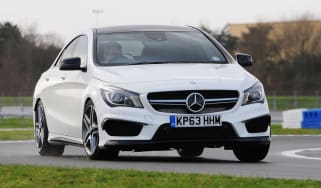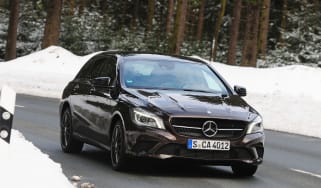Mercedes CLA review
The new Mercedes CLA represents a huge step forward for the brand’s electric models, and EVs in general, highlighted by incredible efficiency and range

Our opinion on the Mercedes CLA
Consider this the start of Europe’s comeback tour in the car world. The new electric Mercedes CLA and its fresh platform, powertrain and interior tech represents a significant step forward across almost all key deliverables. This doesn’t just close the gap to new-age rivals in terms of range and efficiency, but creates a new standard. However, it’ll launch with one arm tied behind its back due to its incompatibility to most public fast-charging stations in the UK.
| Key specs | |
| Fuel type | Electric |
| Body style | Saloon |
| Powertrain | 1 or 2x e-motor, 84kWh |
| Safety | 5* |
| Warranty | Three years, unlimited mileage |
About the Mercedes CLA
This is ‘the big one’ for Mercedes. Not in terms of size, as the CLA will effectively be the new entry-level model for the range moving forward, but in terms of impact as it’s the first of four new models on a brand new MMA architecture. It’s also the first to feature a next generation electronic brain that’ll underpin all new models from here on in – this is Germany’s first ‘software defined vehicle’.
We’ve heard a lot about this new era of electric cars, but what does that actually mean for customers? In the case of the new CLA 250+ with EQ Technology, as it’s formally known, this compact saloon is knocking on the door of offering 500 miles from a single charge, plus ultra-fast charging capability which together should go some way to alleviate the biggest road block for many EV users: range anxiety.
Used - available now

2023 Ford
Puma
13,265 milesManualPetrol1.0L
Cash £16,346
2019 Ford
Kuga
45,876 milesManualDiesel2.0L
Cash £14,199
2023 Ford
Kuga
19,739 milesAutomaticPetrol2.5L
Cash £21,460
2021 Vauxhall
Mokka
14,173 milesManualPetrol1.2L
Cash £14,999This car and the promise of Mercedes catching up to EV specialists like Tesla and BYD has been a long time in the making, but it’s time to test those claims in the real world to see if the German premium brand can deliver on its promises.
But first, the new CLA might need a little explanation as it also represents a new direction and a new naming structure for the brand. This CLA with EQ Technology refers only to models fitted with an all-electric powertrain, but a hybrid-powered CLA will also be along shortly with an identical body and interior. A next-gen Shooting Brake bodystyle is also on the way, but a replacement for the A-Class hatchback will not be coming – hence the new CLA now taking the reins as the entry-point into the Mercedes range.
In a wider context, it means new electric Mercedes models will no longer feature a unique ‘EQ’ name, so the next-gen EQA and EQB that will also come from this new MMA architecture will instead switch back to GLA and GLB using the ‘EQ Technology’ modifier to signify their electric powertrains.
Mercedes will launch the CLA with this 250+ powertrain initially, but a dual-motor 350 and entry-level 250 with a smaller battery pack will be along in the next six months. By this time, we’ll have more details on the hybrid, so too a high performance AMG version with an electric powertrain. However, a new-age CLA 45 S with a high performance four-cylinder petrol engine doesn’t seem to be on the cards.
The CLA 250+ will initially be available in three trims in the UK, starting from just over £47,000, rising to around £49,000 for the AMG Line and £51,000 for the top-spec AMG Line Premium Edition. This is a lot for a CLA but it’s not for a 450-mile-plus EV, creating somewhat of a paradox.
In terms of rivals, the CLA’s high range figure and compact size means it sits in a bit of a vacuum in terms of direct competition. It’s priced above the slightly larger Tesla Model 3 and is on-par with the Polestar 2, but offers more range than both. Audi doesn’t really have any saloon-like EVs in this space for the moment and BMW’s larger i4 costs from around £51,000, but offers nowhere near the range at just 311 miles. Looking at more eccentric rivals, the new DS No8 actually offers a similar combination of electric range and posh-ness at a remarkably similar price point, if not form.
Configure your perfect Mercedes CLA through our Find A Car service now. Alternatively, check out the best deals out there on a new Mercedes CLA from stock or top prices on used Mercedes CLA models...
Performance & driving experience
Pros |
Cons |
|
|
It’s fair to say that in the driving experience department, Mercedes had some work to do, as a majority of its previous electric models were a bit off the pace; we’re happy to report that in just about every quantifiable measure the new CLA is a significant improvement. Mercedes has taken the decision, rightly, not to hunt down ultimate dynamics or Tesla-like immediacy, but a more measured and consistent feel right across the board.
This is exemplified most with the ride, which is superbly judged between being controlled and composed while still offering a plush and cosseting quality. The 18-inch wheels fitted to most models in the UK are perfectly sized to steamroll over a majority of road imperfections, backed up by springs and dampers that perfectly complement the overall driving experience.
Hit the throttle and there’s a clean, clear and consistent sense of acceleration, but it’s the brakes that are the most obvious improvement; you no longer need to second-guess how much bite every press of the brake pedal might elicit. This is down to the all-new braking system introduced for this generation of CLA, seamlessly blending the friction and regenerative braking systems into one that would ‘almost’ have you think it was a purely friction setup.
The only bug was coming to a complete stop, as the pedal seems to run away from you just as you want to come to a halt. It’s something owners will adapt to, but it is a little annoying.
Elsewhere the steering is accurate, if a little light, and overall refinement is excellent, both on account of the completely silent powertrain (aside from a little bit of computerised warble in certain modes) and the impressive aero efficiency which keeps wind noise to a minimum. To achieve this, the wing mirrors had to be downsized, but visibility down the car’s side is still good, although the rearward view is little restricted on account of the shallow rear windscreen.
In all, the new CLA finally seems to live up to the promise of the three-pointed star on the nose, with a level of refinement and comfort you’d expect from a brand like Mercedes. Compared to the previous CLA and A-Class models it’s in a different league, and is comfortably ahead of a Tesla Model 3 or Polestar 2.
The CLA is not particularly fun or engaging to drive, but that’s not really the point with a hyper-efficient EV – a more aggressive and powerful AMG version will have to answer that call when it arrives next year.
Performance, 0-60mph acceleration and top speed
The CLA 250+ is made up from a relatively simple recipe that’s flexible and built on efficiency above all else. The MMA platform might share its structure with a forthcoming combustion variant, but is still cleverly packaged enough to offer a big under-bonnet bootspace for extra storage and a completely flat floor.
The entire 85kWh battery pack is mounted under the cabin floor, with a 268bhp e-motor mounted on the rear axle. This makes it rear-wheel drive and, despite not having much in the way of sporting pretensions, will get to 62mph in 6.7 seconds. Being German, top speed is still somewhat Autobahn-friendly at 130mph, but it’s a niche skillset for most UK drivers.
On the road, we found that performance is more than enough to keep up with fast moving traffic. It’s comparable to single-motor versions of the Tesla Model 3 and Polestar 2, and while never alarmingly fast, it’s more than adequate considering it pairs the lowest-powered e-motor with the biggest and therefore heaviest battery pack. Speaking of which, Mercedes quotes a weight figure of 2,055kg, which is impressive considering the capacity of that battery pack.
We also got the chance to have a go in the dual-motor CLA 350 that’ll be arriving in 2026. This model compromises on a bit of boot space up front, but ups the power figure to 349bhp therefore cutting the 0-62mph to just 4.9 seconds. The extra performance is certainly felt, and thanks to the instant punch of the e-motors probably wouldn’t have too much trouble keeping up with previous generation AMG models.
To get an accurate valuation of a Mercedes CLA, check out our free car valuation tool...
| Model | Power | 0-62mph | Top speed |
| Mercedes CLA250+ | 268bhp | 6.7 seconds | 130mph |
Range, charging & running costs
Pros |
Cons |
|
|
Electric range, battery life and charge time
When you speak to any of the CLA’s chief engineers, it’s clear that the central ambition on this project was to eek as much range out of it as possible. On that metric, the CLA is a huge success. So the numbers: Mercedes quotes a peak range figure of 483 miles on a CLA 250+ as fitted with the aero-focused 18-inch wheel design. This drops little by little on the AMG Line models, but never below 461 miles, even with the larger 19-inch wheel option.
But the reality of these numbers in the real world is a different matter, and we’re happy to report that while it won’t quite match those figures, it does get closer than you might expect. Across a range of motorways, A-roads and city driving we tested the car on, we managed an impressive 4.8m/kWh which, when extrapolated, would see a range of 408 miles. At around 80 per cent of the WLTP figure, this is a huge result.
For context, a Tesla Model 3 Long Range will top out at 436 miles on the WLTP cycle, with Polestar’s long-range 2 only just breaking the 400-mile mark at 408 miles. How close the pair actually get to those figures in the real world are also under the same scrutiny, so don’t expect either to crack the 400 figure with a human at the wheel. The only rival model that currently gets close in the CLA’s pricing orbit is the DS No8, which has a 483-mile range on paper, but does so with a bigger 100kWh battery.
But the MMA platform doesn’t reach those numbers at the expense of usability, as the 800V architecture allows 320kW charging at all 800V chargers, which will see the car accrue around 200 miles in just 10 minutes of charging. However, there is a huge caveat to this top-line fast-charging figure and that’s because Mercedes has launched CLA without the ability to charge at 400V DC fast-charging stations, which make up the vast majority of public chargers in the UK.
This is a big issue for Mercedes, essentially rendering fast public charging largely pointless, as almost all rapid and ultra-rapid chargers run on an older 400V system; from 22kW points all the way up to 250kW units. More 800V units are being rolled out in the UK, and they can be easily located on Merc’s in-built user interface, but it’s not really a solution when rivals don’t have the same issue. Mercedes says a fix is in the works, but it could take one or even two model years to get it plumbed in. A converter is available on left-hand drive models for the main European and American markets, but we’ll have to wait for a right-hand drive solution.
| Model | Battery size | Range | Insurance group |
| Mercedes CLA with EQ Technology | 85kW | 461-483 miles | TBC |
Interior, design & technology
Pros |
Cons |
|
|
The other part of this CLA’s new-ness is the digital interface and operating system, which once again is all-new for this car and due to be spread right across the Mercedes range. In the case of CLA, the main dashboard is one piece of gloss-black plastic integrating a 14-inch touchscreen and 10.25-inch driver’s display. Some models have a second 14-incher on the passenger side, but most will do with just the one and the passenger side featuring a black-panel with glowing stars.
But these screens are so vast, there hasn’t really been much space left for anything that looks ‘designed’, leading to a vibe that’s more Curry’s PC world than boutique hotel. Below the black panel sits a centre console with two cupholders, behind which is a small cubby. There are some flourishes, such as the intricate door cards and glass roof, but digital real-estate aside, there’s not much else going on.
Infotainment, sat-nav and stereo
On the face of it, the CLA’s infotainment system looks and reacts much like the units found on pretty much all other Merc’s, but hiding within the system is a new electronic architecture that underpins all of its operations. Put simply, without really making a song and dance of it, this is one of Europe’s first so-called software-defined vehicles, with all the various tech working off the one base system and a deep-routed but flexible connection to the cloud, bringing with it benefits like over-the-air updates, enhanced online services and an AI-assisted voice command system.
The ‘zero layer’ interface works brilliantly, with super-fast responses and enough digital real estate to house all the main controls without any issues. The homescreen always displays a navigation screen that can be mirrored onto the driver’s display, with little tiles giving quick access to your phone, media and more – not unlike the dock on an iMac. The real boon here, though, is that the responses and clarity of menus are just as good as a smartphone or tablet.
The air-con and ventilation controls are digital, but can be accessed on the main screen. The tiles are a touch small, and there’s nowhere to rest your hand to help guide your finger whilst driving, but it’s a reasonably elegant system that’s intuitive and easy to use in a way current Mercedes systems aren’t.
There are then more controls, such as a volume slider and drive modes on a black panel at the base of the screen alongside a phone charging pad. We found that these are a little difficult to reach, but certainly aren’t the worst. Would we prefer physical controls? Yes. But with so much digital real-estate, it’s not the buzzkill that it has been in the past.
Boot space & practicality
Pros |
Cons |
|
|
It’s important to remember the CLA is more compact than a Tesla Model 3-sized saloon, evidenced by the relatively cramped cabin and limited boot space. That’s not to say the CLA is tiny – in actual fact the longer wheelbase, glass roof and flat floor makes the second row a much nicer place to spend time than the previous model – but it’s not generous and won’t, for example, be particularly suitable as a fleet vehicle which involves back seat passengering.
Up front, the seats are comfortable, and in order to see over the massive screens the somewhat high driving position is beneficial, but as a result the low and cocooned feeling of the previous CLA is a thing of the past.
| Dimensions | |
| Length | 4,723 |
| Width | 1,855 |
| Height | 1,468 |
| Number of seats | 5 |
| Boot space | 405l (+ 101l front) |
Dimensions and size
Just like before, the CLA is more of an Audi A3 saloon rival than that of cars like the Tesla Model 3 and Polestar 2, despite costing the same or more than that pair. The CLA is also relatively tall and narrow for a car of this capability – this is good news for drivability in towns and cities, but leads to an awkward exterior design on account of the technical package.
Boot space
The 405-litre boot is pretty standard, but comes with some underfloor storage for the cables which is a nice touch. All single-motor CLAs also come with a generous front boot of 101 litres which is great for stashing charging cables.
Towing
Mercedes offers an 1,800kg towing capacity on all CLA with EQ Technology models.
Reliability & safety
Pros |
Cons |
|
|
Being a brand new generation of car there’s no real data about reliability, but an added bonus of the simplified electronic architecture should help keep the bugs at bay.
| Key standard safety features | Euro NCAP safety ratings |
|
|
Buying and owning
There’s no reason to spend more on the more unattractive, less efficient and very un-sporty AMG Line. The key elements are all there in the base Sport Edition – a panoramic roof, the same charging speeds and the 14-inch infotainment system.
Mercedes CLA alternatives
This is where things get tricky, as the CLA is an exceptional car in isolation, but when considered in context of other cars in the market, its inflated price point and superb range mean it’s outgrown its former class and now headbutts into the sector above without the physical dimensions to support it.
A Tesla Model 3 Long Range is around 50 miles down in range, on paper, has a more basic-looking and feeling cabin and doesn’t feel half as well tuned for European roads, but it’s cheaper, has more space inside and comes with the added bonus of a supercharger network. As fans of engineering prowess, we’d suggest the Mercedes is the superior car, but Tesla’s overall package is still a tough one to bet against.
Things get easier against cars like the Polestar 2, which offer less of everything important, apart from space and practicality, for much the same price. We love the eccentric flair of the DS No8, and its range and price point are pretty similar to the Mercedes, despite being a class bigger (and then some). However, it’s quite a bit slower in a straight line, and is less efficient as it takes another 15kWh of battery size to match the Merc’s range figure.
Deals on the Mercedes CLA and alternatives
Frequently Asked Questions
Yes
More reviews
Car group tests
In-depth reviews
Road tests
Which Is Best
Most Economical
- NameCLA 250+ 200kW EQ Tech AMG Line Ed 85kWh 4dr Auto
- Gearbox typeAuto
- RRP£49,955

